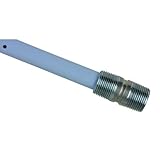Imagine stepping into a hot shower, only to be met with an unexpected blast of cold water. Frustrating, right? Surprisingly, a small component called the dip tube could be the culprit.
Many homeowners are unaware of the dip tube’s role in their water heater. When it fails, it can lead to a significant reduction in usable hot water and clogging of faucets with plastic debris.
How a Dip Tube Works: The Science Behind Your Hot Water
Let’s explore how a dip tube works in your water heater.
How a Dip Tube Works: The Science Behind Your Hot Water
- Cold water delivery: Cold water enters the water heater through the dip tube at the top.
- Directed to the bottom: The dip tube channels this cold water directly to the tank’s bottom, near the heating element or burner.
- Heating process: At the bottom, the water is heated by the burner or heating element.
- Hot water rises: As the water heats up, it naturally rises to the top of the tank, ready for your use.
Think of it like pouring milk into a bowl of cereal without disturbing the layers—the dip tube ensures cold water is delivered to the bottom, allowing hot water to remain at the top for immediate use.
Why the Dip Tube Matters
The dip tube is crucial for your water heater’s performance. It directs cold water to the tank’s bottom, ensuring efficient heating. This process prevents cold water from mixing with hot water at the top, maintaining a steady hot water supply.
If the dip tube fails, cold water can mix with hot water, leading to lukewarm temperatures. Additionally, a broken dip tube can disintegrate, causing plastic particles to clog faucets and reduce water pressure.
Signs Your Dip Tube Is Failing
If you’ve noticed lukewarm water or sudden temperature changes during your shower, it could be a sign of a faulty dip tube. Another indicator is a shortened supply of hot water, meaning your hot water runs out faster than usual.
Additionally, finding white or gray plastic debris in your faucets suggests the dip tube might be deteriorating. Unexplained increases in your energy bills can also point to this issue, as your water heater works harder to maintain the desired temperature.
Here’s a simple checklist to help you identify potential dip tube problems:
| Symptom | Possible Cause |
|---|---|
| Lukewarm water or temperature changes | Dip tube deterioration |
| Shortened hot water supply | Dip tube breakage |
| White/gray plastic debris in faucets | Dip tube disintegration |
| Unexplained spikes in energy bills | Water heater inefficiency |
Diagnosing Dip Tube Issues
Diagnosing dip tube issues in your water heater is essential for maintaining efficient hot water delivery. Here’s how you can inspect and test your dip tube:
Inspection Steps
- Turn Off Power and Water Supply: Before starting, ensure your safety by turning off the water heater’s power source and shutting off the cold water supply valve.
- Drain the Tank: Connect a garden hose to the drain valve at the bottom of the tank. Open the valve to drain the water into a suitable drainage area.
- Locate and Inspect the Dip Tube: The dip tube is connected to the cold water inlet at the top of the tank. Carefully remove the inlet pipe to access the dip tube. Examine it for any cracks, breaks, or signs of disintegration.
DIY Tests
- Monitor Water Temperature: After reassembling the components, run hot water from a faucet. If the water turns cold quickly or doesn’t reach the desired temperature, it may indicate a dip tube issue.
- Check for Debris: Inspect faucet aerators and showerheads for white or gray plastic particles, which could be remnants of a deteriorating dip tube.
When to Call a Professional
If you encounter complex leaks, are uncertain about the inspection process, or prefer expert assistance, it’s advisable to contact a licensed plumber. They can accurately diagnose the problem and perform necessary repairs or replacements.
Step-by-Step Dip Tube Replacement Guide
Replacing a dip tube in your water heater can restore its efficiency. Here’s a concise guide to help you through the process.
Tools Needed:
- Pipe wrench
- Teflon tape
- Bucket
- Replacement dip tube
Steps
- Turn Off Power and Water: Ensure safety by switching off the water heater’s power source and closing the cold water supply valve.
- Drain the Tank: Attach a hose to the drain valve at the tank’s base, directing the water into a bucket or suitable drainage area.
- Remove the Old Dip Tube: Disconnect the cold water inlet pipe using the pipe wrench. Extract the existing dip tube carefully.
- Install the New Dip Tube: Wrap Teflon tape around the threads of the new dip tube. Insert it into the cold water inlet, ensuring a secure fit.
- Refill the Tank and Restore Power: Open the cold water supply valve to refill the tank. Once full, turn the power back on and test for proper operation.
Safety Tips
- Wear gloves to protect your hands.
- Avoid overtightening connections to prevent damage.
DIY vs. Professional Replacement
Replacing a dip tube yourself can be cost-effective. A replacement dip tube typically costs between $20 and $50. Hiring a professional may cost between $100 and $500, depending on labor rates and complexity.
Preventing Dip Tube Failure
Regular maintenance of your water heater’s dip tube is essential for ensuring efficient performance and extending the appliance’s lifespan. Here are some practical tips to help you prevent dip tube failure:
1. Annual Tank Flushing
Over time, sediment can accumulate at the bottom of your water heater tank, potentially leading to dip tube damage and reduced efficiency. To prevent this, it’s advisable to flush your tank annually. This process involves draining the tank to remove sediment buildup, thereby maintaining optimal performance.
2. Install a Water Softener
Hard water contains high levels of minerals like calcium and magnesium, which can contribute to sediment buildup and accelerate dip tube wear. Installing a water softener can mitigate these effects by reducing mineral content, thus prolonging the life of your dip tube and water heater.
3. Replace the Anode Rod Every 3–5 Years
The anode rod in your water heater attracts corrosive elements, protecting the tank and dip tube from rust and corrosion. Over time, the anode rod depletes and should be replaced every 3 to 5 years to continue safeguarding your system. Regular inspection and timely replacement of the anode rod can prevent premature dip tube failure.
4. Monitor Water Temperature Settings
Maintaining your water heater’s temperature at around 120°F (49°C) is recommended. Temperatures set too high can cause excessive wear on components, including the dip tube, while also posing a scalding risk. Regularly check and adjust the thermostat to ensure it remains at a safe and efficient setting.
5. Schedule Professional Inspections
While regular DIY maintenance is beneficial, scheduling professional inspections can help identify potential issues that may not be apparent to the untrained eye. A licensed plumber can assess the condition of your dip tube and other components, providing recommendations to prevent future failures and ensure the longevity of your water heater.
Dip Tube Materials: Plastic vs. Metal
When it comes to water heater dip tubes, the material used plays a significant role in performance and durability. Dip tubes are typically made from either plastic or metal, each with its own set of advantages and drawbacks.
Plastic Dip Tubes
- Affordability: Plastic dip tubes, commonly made from materials like PVC or polypropylene, are cost-effective and widely used in water heaters.
- Susceptibility to Cracking: Over time, exposure to high temperatures and water chemistry can cause plastic dip tubes to become brittle and crack, leading to potential failure.
Metal Dip Tubes
- Durability: Metal dip tubes, often constructed from corrosion-resistant metals such as copper or stainless steel, offer enhanced durability and a longer lifespan compared to their plastic counterparts.
- Higher Cost and Rarity: Despite their advantages, metal dip tubes are less common and come at a higher price point, making them a less prevalent choice in standard water heater installations.
Here’s a comparison to help you understand the key differences:
| Feature | Plastic Dip Tubes | Metal Dip Tubes |
|---|---|---|
| Durability | Prone to cracking and degradation over time | Highly durable and resistant to wear and tear |
| Cost | More affordable, making them a common choice in many water heaters | More expensive due to the use of materials like copper or stainless steel |
| Availability | Widely available and used in most standard water heaters | Less common, often found in specialized or high-end water heating systems |
| Ideal Use Case | Suitable for standard residential water heaters with regular maintenance | Ideal for situations where longevity and durability are prioritized, despite higher cost |
Final Thoughts
Reflecting on the dip tube’s role in your water heater reveals its critical function in delivering consistent hot water. This unassuming component ensures that cold water is efficiently heated, maintaining the comfort we often take for granted.
Neglecting the dip tube can lead to unexpected inconveniences, such as lukewarm showers or increased energy bills. Regular maintenance and awareness of this part can prevent such issues. It’s a reminder that even the smallest components in our home systems deserve attention to ensure overall efficiency and comfort.
Water Heater Dip Tube (FAQs)
What is a water heater dip tube?
A dip tube directs incoming cold water to the tank’s bottom, ensuring efficient heating.
How do I know if my water heater dip tube is bad?
Signs include sudden water temperature changes and plastic particles in fixtures.
How much does it cost to replace a dip tube?
Replacement dip tubes cost around $25.
Will a water heater work without a dip tube?
Without a dip tube, cold water mixes with hot, reducing efficiency and causing temperature fluctuations.
Can you replace a water heater dip tube?
Yes, replacing a dip tube is manageable with basic tools and safety measures.
Is it OK to turn off a hot water heater?
Turning off your water heater is safe during maintenance or extended absences.
How critical is a dip tube in a water heater?
The dip tube is essential for efficient water heating and consistent hot water supply.
How long does a dip tube last?
Typically, a dip tube lasts between 8 to 12 years, depending on water quality and maintenance.
Can I replace a dip tube myself?
Yes, with basic tools and safety precautions, you can replace a dip tube. However, if you’re unsure or uncomfortable, it’s advisable to consult a professional.
Does a broken dip tube affect water quality?
Yes, a deteriorating dip tube can release plastic debris into your water supply, leading to clogged faucets and reduced water quality.
How does a dip tube function in an electric water heater?
In an electric water heater, the dip tube directs cold water to the tank’s bottom, ensuring efficient heating.
What materials are commonly used for dip tubes, and why?
Dip tubes are typically made from durable materials like cross-linked polyethylene (PEX) due to their flexibility and resistance to high temperatures.
What happens if a dip tube breaks in a water heater?
If a dip tube breaks, cold water mixes with hot water at the top, leading to lukewarm temperatures and reduced efficiency.
How can regular water heater maintenance extend the lifespan of a dip tube?
Regular maintenance, such as annual tank flushing to remove sediment, helps prevent dip tube deterioration and extends its lifespan.

Mark Bittman is a public health expert and journalist who has written extensively on food, nutrition, and healthy living. He has a wealth of knowledge to share when it comes to solving problems with appliances. In addition, he can help you choose the right appliances for your needs, optimize their performance, and keep them running smoothly.


